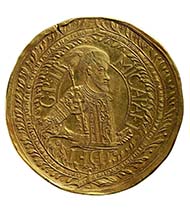by courtesy of the Berlin Coin Cabinet
on the occasion of its exhibit “Gold Giants”
Coins weighing 100 ducats are the top tier of modern numismatics. Only a few Coin Cabinets prides themselves to have such rarities. Until the 20th century, they mark the upper limit of donatives in the form of coins. Only in the 21st century, coins exceeded that magical threshold. With donative medals, the threshold was crossed already in the 17th century.
Medallion worth 100 ducats, 1677. Michael I Apafi (1661-1690), Prince of Transylvania. Gold, 346.74 g, 85 mm, 12 h. Vienna Coin Cabinet, inv. 68 bß.
The Transylvanian Prince Michael Apafi issued 100 ducat pieces in 1674, 1675, 1676, 1677 and 1683. In contrast to the ones produced in 1674-1674 and 1683, which are circular gold slabs with the taler die of the individual year in the centre surrounded by 10 ducat dies, for the year 1677 a special pair of oversize dies was created. The design most probably was modelled on the Bohemian representational piece of 50 ducats of Ferdinand III from 1629. Two patterns worth 100 and another one worth 50 ducats, respectively, were made from this pair of dies – or, rather, are known to exist today. This piece of the Vienna Coin Cabinet was a present Michael Apafi gave to Emperor Leopold I, the other one received Apafi’s general, Count Andrassy. The latter pattern was subsequently incorporated into the collection of the Prince of Montenuovo and is housed by the Hungarian National Museum in Budapest today.
It is interesting to know that the master of these gold giants himself commented even on the coins very sceptical on the value of gold and feared for the salvation of his soul. The Latin legend on the obverse reads: “The lustre of all the gold treasures of the world does not make me happy – I fear that that all this does my Christ [the salvation of my soul] harm.”
Michael Apafi, son of George Apafi who was town judge in Hermannstadt, came from an old Transylvanian noble family: He was elected Prince of Transylvania by the classes in 1661 under pressure of the Turks instead of John Kemeny who was loyal to the Emperor. Apafi was a loyal supporter of the Porte and only sought a rapprochement with the Emperor after the Turkish defeat at the Gates of Vienna in 1683. In 1686, he acknowledged the supremacy of Emperor Leopold I who in turn affirmed him as Prince of Transylvania. After the Ottomans were defeated again in 1687, Apafi as their supporter was likewise obliged to pay a contribution of 700,000 gold gulden. The election of his minor son, who bore the same name, aroused yet another conflict with the Emperor which, however, was compounded with the “Leopoldine Diploma” in 1691. Michael II Apafi, who was under the guardianship of Emperor Leopold, renounced the rule in Transylvania for compensation in 1697.
This gold giant can be viewed in the exhibit of the Berlin Coin Cabinet bearing the same title. For more information click here.





